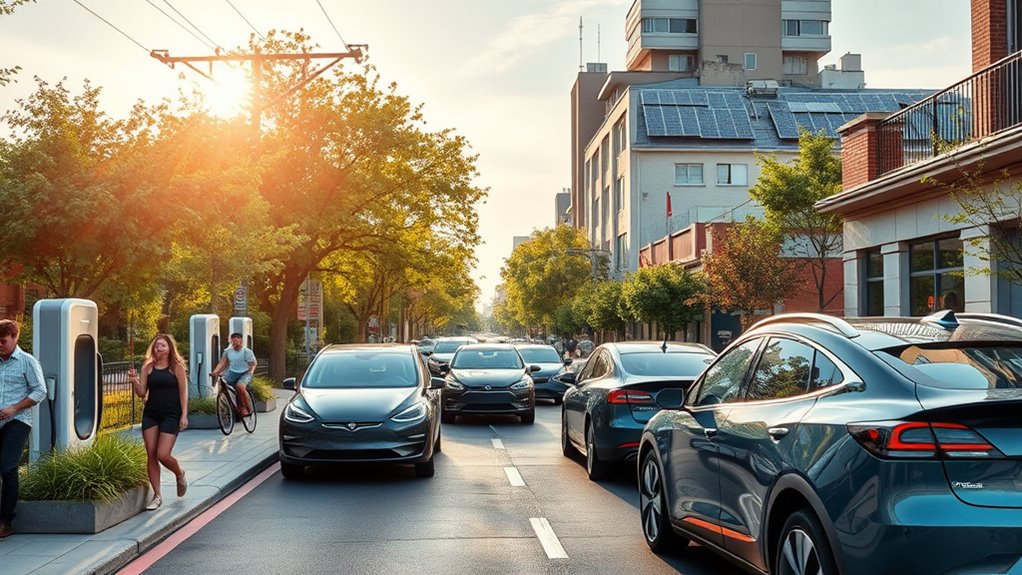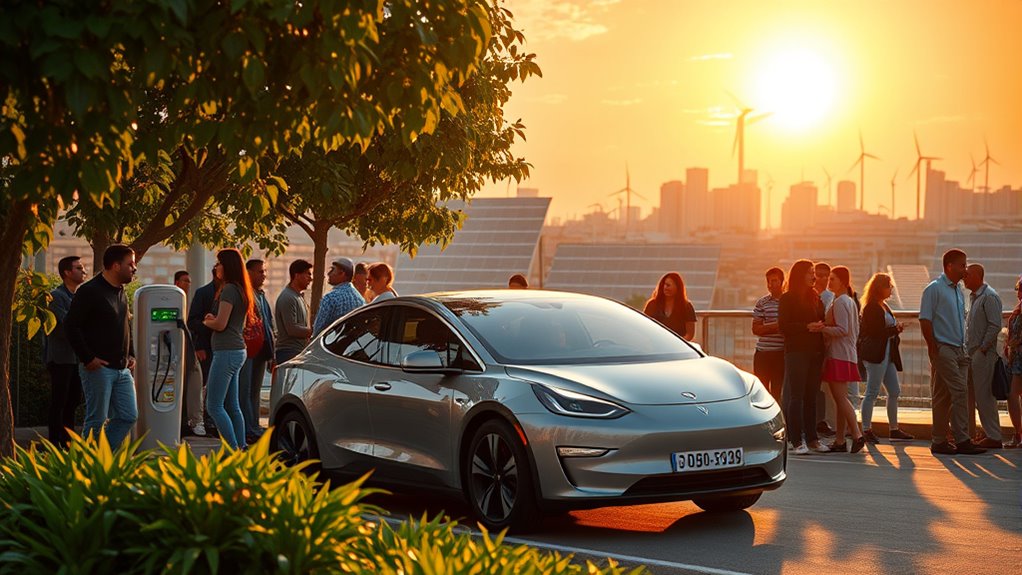Electric vehicles (EVs) are essential for sustainable transportation. They cut greenhouse gas emissions and improve air quality by producing zero tailpipe pollutants. You’ll also save on fuel and maintenance costs. With advancements in technology, EVs are becoming more efficient and user-friendly. Plus, they contribute to quieter streets and healthier urban living. Interested in how EVs are changing the future of transport? Keep exploring to discover the broader impact on our environment and society.
Key Takeaways
- Electric vehicles (EVs) produce zero tailpipe emissions, significantly improving air quality and reducing greenhouse gas emissions in urban areas.
- The transition to EVs leads to lower fuel and maintenance costs, promoting economic stability and savings for consumers.
- Government incentives and support for EV infrastructure make electric mobility more accessible and encourage widespread adoption among communities.
- Advancements in battery technology and charging infrastructure enhance the practicality and convenience of using EVs for daily transportation needs.
- Integrating EVs into smart city plans fosters sustainable urban environments, encouraging active transportation and reducing noise pollution.
Environmental Benefits of Electric Vehicles

As you consider the environmental benefits of electric vehicles (EVs), it’s clear that they play an essential role in reducing greenhouse gas emissions.
EVs produce zero tailpipe emissions, which means they greatly cut down on harmful pollutants compared to petrol and diesel cars. By adopting EVs, you can save an average of 1.5 million grams of CO2 annually—equivalent to four return flights from London to Barcelona. Additionally, many eco-friendly accommodations, such as eco lodges in Costa Rica, encourage the use of EVs as part of their commitment to sustainable tourism. Furthermore, the integration of solar energy solutions into charging stations can maximize the environmental benefits of EVs.
In the U.S., a 25% adoption rate could reduce CO2 emissions by about 242 million tons each year. Additionally, when paired with renewable energy solutions, charging EVs further enhances the reduction in greenhouse gas emissions, making the shift toward cleaner transportation even more impactful. This shift toward cleaner transportation not only benefits the planet but also enhances public health and air quality, making EVs a much more energy efficient option compared to traditional petrol cars.
Enhancing Energy Efficiency

Electric vehicles not only contribute to environmental sustainability but also prioritize energy efficiency, allowing drivers to maximize their range and performance.
By utilizing enhanced components like Electric Drive Units and eAxles, you enhance powertrain efficiency. Effective thermal management keeps your battery and motor operating safely and efficiently. Optimizing heating and cooling systems can save up to 540 W, enhancing driving range. Additionally, implementing geothermal heat pumps can further improve energy efficiency in home charging stations, making the charging process more sustainable. Furthermore, adopting lightweight materials in vehicle design significantly reduces overall weight, leading to improved energy efficiency. Upgrading to high-efficiency motors can also contribute to better performance and lower energy consumption.
Digital twin technology helps simulate conditions, identifying inefficiencies without needing hardware changes. Lightweight materials further improve efficiency, while efficient motors boost performance and lower emissions.
Additionally, advanced cooling systems maintain ideal battery temperatures, prolonging battery life. Smart control systems dynamically adjust heating and cooling based on real-time conditions, ensuring you get the most out of every charge.
With these innovations, your electric vehicle can deliver a more efficient driving experience.
Improving Urban Livability

While shifting to electric vehicles (EVs) enhances urban livability, it also paves the way for cleaner, healthier cities. By reducing greenhouse gas emissions and eliminating tailpipe pollutants, EVs considerably improve air quality, which can lead to better public health and fewer respiratory issues. You’ll notice quieter streets, encouraging walking and cycling, which promotes active transportation. As cities invest in charging infrastructure, urban landscapes transform, creating more pedestrian-friendly environments. Furthermore, integrating EVs into smart city frameworks supports sustainable urban planning, making cities more resilient to climate change. Hydrogen fuel cells can also play a role in this transition by providing renewable energy sources that further support clean transportation. Electric vehicles (EVs) not only foster economic opportunities but also align with your desire for a livable, vibrant community, ultimately enhancing your quality of life. The transition to EVs can also drive innovation in renewable energy technologies, further supporting sustainable practices across urban environments. Additionally, the adoption of intelligent tutoring systems can facilitate educational opportunities that equip future generations with the skills necessary to thrive in a sustainable economy.
Driving Technological Advancements

The adoption of electric vehicles is driving significant technological advancements that enhance not only vehicle performance but also the overall user experience.
You’ll appreciate modern EV batteries, boasting higher energy density for longer ranges and faster charging times—many reaching 80% in under an hour. With improved lifespan and recycling capabilities, these batteries are built to last. Advancements in battery technology have also contributed to increased accessibility for a broader audience. In addition, Natural Language Processing (NLP) is being utilized in in-car systems to create more intuitive user interactions.
Artificial intelligence plays an essential role, offering predictive maintenance and personalized driving experiences, easing range anxiety.
Charging infrastructure is evolving too, with ultra-fast and wireless options making recharging a breeze.
Advanced Driver Assistance Systems (ADAS) enhance safety with features like automated emergency braking and real-time traffic integration, ensuring a smoother journey.
Together, these innovations are reshaping the future of transportation.
Economic and Social Advantages

As communities embrace electric vehicles, they unfasten a range of economic and social advantages that benefit everyone.
You’ll enjoy reduced oil dependence, leading to more stable fuel costs and lower maintenance expenses—saving you around $5,000 over the vehicle’s lifespan. Additionally, the transition to EVs helps to reduce greenhouse gas emissions, contributing to a healthier environment for future generations. The integration of sustainable travel options in the EV sector can further enhance community engagement and tourism. Moreover, the growth of the EV sector aligns with key industries attracting funding, fostering innovation and investment in local economies. Proper planning can help maximize the benefits of these investments to ensure long-term economic sustainability.
The growing EV sector generates thousands of jobs, from manufacturing to charging infrastructure, particularly in rural areas.
By investing in EVs, your community attracts travelers, boosting local businesses while enhancing public health through improved air quality.
Plus, with government incentives, the shift becomes even more affordable.
Electric vehicles not only promote sustainable living but also foster community engagement and create a cleaner, quieter urban environment.
Embracing EVs means a brighter future for all.
Frequently Asked Questions
What Are the Typical Costs of Charging an Electric Vehicle?
When you charge an electric vehicle, the costs can vary considerably.
At home, you’ll pay about $6.00 to $6.40 for a full charge, averaging around $65.37 monthly for typical driving.
Public charging options range from $1 to $30 per charge, depending on the type and speed.
How Long Does It Take to Charge an Electric Vehicle?
Charging an electric vehicle can take anywhere from a few minutes to several hours, depending on various factors.
If you’re using a DC fast charger, you could reach 80% charge in about 15 to 30 minutes.
Level 2 chargers typically take 4 to 24 hours, while Level 1 chargers can require up to 71 hours.
What Is the Lifespan of an Electric Vehicle Battery?
The lifespan of an electric vehicle battery generally ranges from 8 to 12 years, depending on usage.
You can expect it to last around 280,000 miles or more, with newer models potentially reaching 20 years and 200,000 miles.
To extend your battery’s life, keep it charged between 30% and 80%, avoid deep discharges, and follow manufacturer maintenance guidelines.
With proper care, some batteries have even surpassed 400,000 miles!
Are Electric Vehicles Suitable for Long-Distance Travel?
Imagine a modern-day knight, ready to set off on a quest. Electric vehicles (EVs) can be your trusty steed for long-distance travel.
With improved ranges and rapid charging stations, you won’t be left stranded in the wilderness. Sure, some obstacles like range anxiety may loom, but as charging networks expand, your journey becomes more feasible.
How Do I Find Charging Stations for Electric Vehicles?
To find charging stations for electric vehicles, you can use online directories like PlugShare and the DOE’s Alternative Fueling Station Locator.
Apps like Electrify America also help you locate chargers nationwide.
In Baton Rouge, check local resources like Audi Baton Rouge’s interactive map or visit popular spots like Tanger Outlets Gonzales.
Remember to take into account charging speeds; Level 2 chargers are faster than Level 1, while DC Fast Chargers can save you significant time.
Conclusion
As you consider the future of transportation, think about this: could electric vehicles actually reshape our cities for the better? With their environmental benefits, enhanced energy efficiency, and the potential to boost local economies, EVs might just be the key to a more sustainable and livable world. By embracing this technology, you’re not just making a smart choice for yourself; you’re investing in a healthier planet for future generations. The change starts with you!










